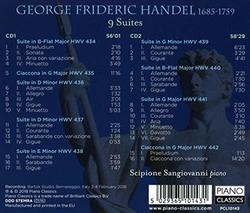| All Artists: Scipione Sangiovanni Title: Handel: 9 Suites Members Wishing: 0 Total Copies: 0 Label: Piano Classics Release Date: 11/9/2018 Genre: Classical Styles: Forms & Genres, Suites Number of Discs: 2 SwapaCD Credits: 2 |
Search - Scipione Sangiovanni :: Handel: 9 Suites
 | Scipione Sangiovanni Handel: 9 Suites Genre: Classical Following the success across Europe of his eight Grand Suites for harpsichord in 1720, albeit in a doctored and pirated edition, Handel resolved to make good on his promise of a sequel. At length this occurred, with the ap... more » |
Larger Image |
CD Details
Synopsis
Product Description
Following the success across Europe of his eight Grand Suites for harpsichord in 1720, albeit in a doctored and pirated edition, Handel resolved to make good on his promise of a sequel. At length this occurred, with the appearance in 1730 of a second volume, now containing nine such suites. Handel appears eventually to have entered into cooperation with the London publisher John Walsh once the Royal Privilege he had secured for the printing of his own works had expired. Thus a radically revised edition of the suites appeared in 1733-4, and it is this that Scipione Sangiovanni has recorded. Like the Grand Suites, the second volume contains both original and arranged music for keyboard composed throughout Handels career, though heavily weighted towards his youth: virtually all the contents predate 1706. Having received no further attention from the mature composer, they retain a sense of the confident if sometimes undisciplined exuberance of his youth. They include the grand, standalone G major Chaconne HWV435 as well as a still more expansive example of the form, HWV442. In recording the suites, Scipione Sangiovanni joins an increasing number of soloists who view the range of tonal possibilities afforded by the modern piano as complementary to the soundworld envisaged by the composer. Having recorded a well-received album of Vivaldis Four Seasons in a solo-piano arrangement, he is practiced in the art of transferring Baroque articulation and idiom to the touch of the piano, which in this case is a Kawai model. The young Italian pianist Scipione Sangiovianni plays the suites on a modern grand piano, in a stylish, natural and utterly musical way, never trying to imitate the harpsichord but letting the music speak for itself. Scipione Sangiovanni is winner of several international piano competitions, among which is the Debut International Piano Competition of New York.
